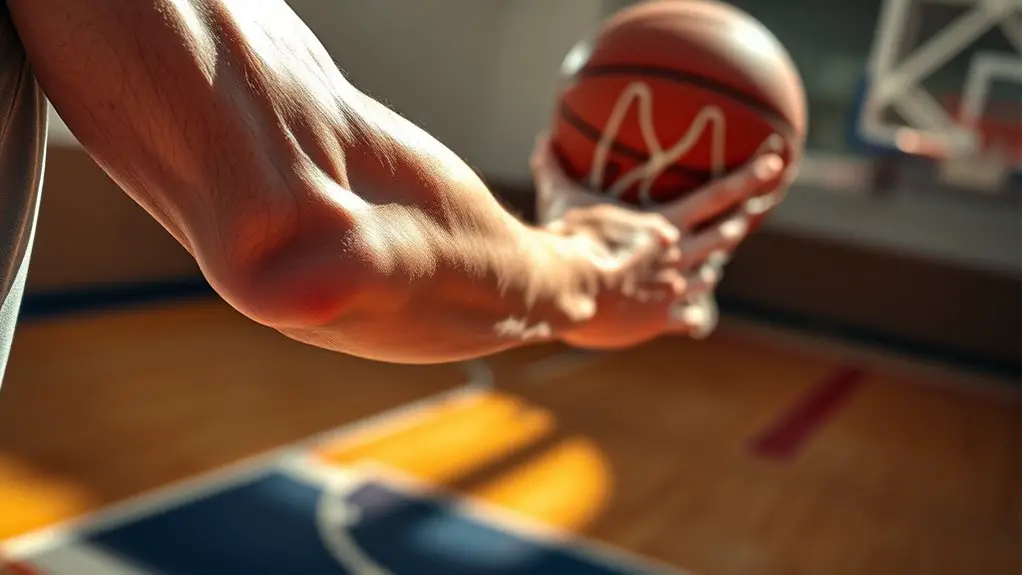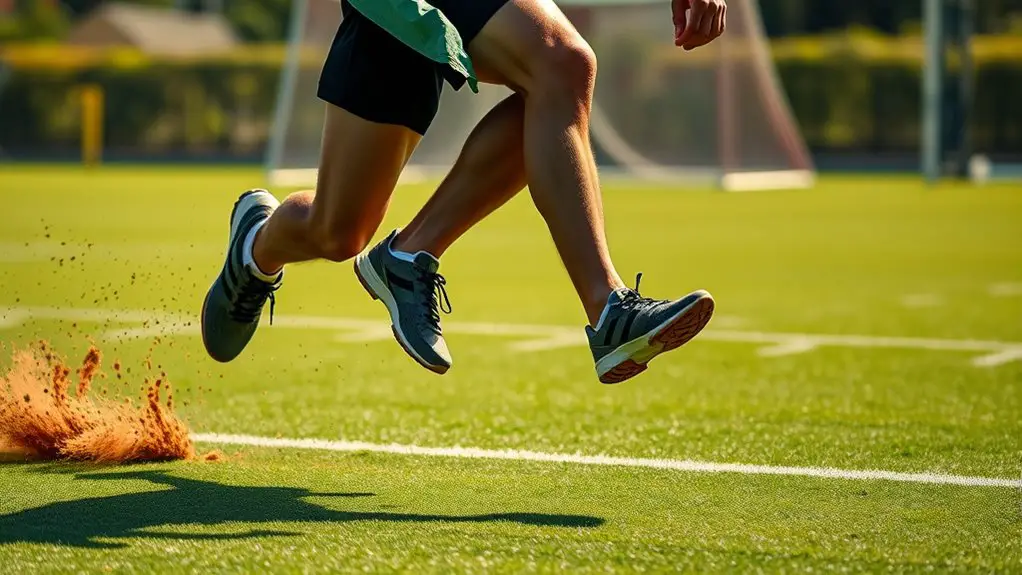To build arm endurance for long innings, focus on strength training exercises like push-ups, tricep dips, and resistance band workouts targeting your biceps, triceps, and forearm muscles. Incorporate cardiovascular activities like swimming or interval training to boost stamina. Don't forget to integrate flexibility workouts and active recovery techniques to support muscle repair. Tracking your progress is key, so you can adjust your training. Stick around to discover more techniques and insights for enhancing your arm endurance!
Understanding Arm Endurance and Its Importance
Arm endurance is essential for anyone looking to enhance their overall fitness and performance. When you push yourself in workouts or sports, you might experience arm fatigue, which can limit your ability to perform at your best. Building endurance in your arms allows you to engage longer in activities without feeling drained, giving you the freedom to explore your limits.
The endurance benefits are vast; increased stamina means you can lift, throw, or swing more effectively. Imagine conquering challenges without worrying about muscle exhaustion. Plus, better arm endurance contributes to improved posture and reduced risk of injury, allowing you to enjoy your activities fully. Additionally, arm strength development is crucial for optimal game performance, especially in sports like baseball and cricket.
Key Muscles Involved in Arm Endurance
To boost your arm endurance, it's important to understand the key muscles that play a role in this process. Focusing on these areas can set you free to perform at your best during long innings:
- Biceps Brachii: These muscles help with flexing your elbow and lifting, giving you the power to throw and swing.
- Triceps Brachii: Essential for extending your arm, these muscles help maintain strength during repetitive actions.
- Forearm Muscles: These are vital for grip strength and coordination, allowing you to control your movements.
- Shoulder Stability and Core Strength: A strong core stabilizes your shoulders, creating a solid base for all arm movements. Additionally, a strong core enhances stability and balance, which is crucial for executing powerful arm movements effectively.
Effective Strength Training Exercises
Incorporating effective strength training exercises into your routine can considerably enhance your arm endurance. Start with basic exercises like push-ups and tricep dips, which engage multiple muscle groups. They're great for building overall arm strength. You might also want to add resistance bands into your workouts. These bands are versatile and can be used for various exercises, like bicep curls and lateral raises, providing constant tension that challenges your muscles throughout the movement.
Don't forget to focus on your shoulders and back as well, since they play a crucial role in arm endurance. Incorporate exercises like shoulder presses or rows with resistance bands. Aim for higher repetitions with lower weights to build endurance rather than bulk. Remember, consistency is key, so make these strength training sessions a regular part of your routine. Additionally, consider squats and deadlifts to further enhance your overall strength, which contributes to better arm endurance. With dedication, you'll notice a significant improvement in your arm endurance for those long innings.
Incorporating Cardiovascular Workouts
While strength training is essential, don't underestimate the importance of cardiovascular workouts in building arm endurance. Cardio benefits extend beyond just heart health; they enhance your overall stamina, allowing you to push through those long innings without feeling drained.
Strength training is vital, but cardiovascular workouts are key for boosting arm endurance and overall stamina.
Here are some ways to incorporate cardio into your routine:
- Interval Training: Alternate between high and low workout intensity to boost endurance.
- Swimming: Engage multiple muscle groups, improving both strength and cardiovascular fitness.
- Cycling: Get your heart pumping while enjoying the freedom of the open road or a scenic path.
- Jump Rope: A simple and effective way to elevate your heart rate and strengthen your arms. Proper hydration during these workouts is crucial, as hydration supports optimal performance and helps prevent fatigue.
The Role of Flexibility and Mobility
Although often overlooked, flexibility and mobility play an essential role in building arm endurance. By enhancing your range of motion, you can improve your performance and reduce the risk of injury. Incorporating mobility routines into your training regimen helps you maintain fluidity in your movements, allowing for longer innings without fatigue. Additionally, prioritizing mobility training reveals your athletic potential and enhances your overall performance.
| Flexibility Benefits | Mobility Routines |
|---|---|
| Increases joint range | Dynamic stretching |
| Enhances blood flow | Shoulder rotations |
| Reduces muscle tension | Arm circles |
| Improves posture | Resistance band exercises |
| Boosts overall strength | Foam rolling |
Make sure to dedicate time to both flexibility and mobility exercises. Embrace these practices, and you'll notice a significant difference in your arm endurance, giving you the freedom to play longer and with more agility.
Nutrition for Optimal Performance
To maximize your arm endurance and overall performance, paying attention to your nutrition is crucial. You've got the freedom to fuel your body right, and it can make all the difference during those long innings. Here are some key strategies:
Maximize your arm endurance and performance by fueling your body with proper nutrition during those long innings.
- Meal Timing: Eat balanced meals 2-3 hours before you play to guarantee your energy stores are full.
- Hydration Strategies: Stay hydrated throughout the day; aim for at least half your body weight in ounces of water.
- Post-Game Nutrition: Replenish with protein and carbohydrates within 30 minutes after playing to kickstart recovery, as consuming nutrients during this window can enhance muscle absorption.
- Snacks: Keep healthy snacks on hand during the game to maintain energy levels, like nuts or energy bars.
Recovery Techniques to Enhance Endurance
After pushing your limits, it's essential to incorporate recovery techniques that can boost your arm endurance. Active recovery methods, along with stretching and mobility exercises, can help you bounce back faster and improve your overall performance. Proper nutrition strategies are also vital for enhancing recovery and ensuring sustained endurance during long innings. Let's explore how these strategies can make a difference in your training routine.
Active Recovery Methods
Active recovery methods play an essential role in enhancing arm endurance by promoting muscle repair and reducing fatigue. Incorporating these recovery techniques into your routine can help you feel free and energized:
- Light Cardio: Engage in gentle activities like jogging or cycling to boost blood flow without overexerting yourself.
- Dynamic Movements: Include motions that mimic your sport to keep your muscles engaged, like arm circles or shoulder rolls.
- Foam Rolling: Use a foam roller to target tight spots and improve circulation, making your muscles feel rejuvenated.
- Hydration and Nutrition: Fuel your body with water and nutritious foods to aid recovery and maintain energy levels.
Embrace these methods, and you'll not only recover faster but also build lasting endurance for those long innings!
Stretching and Mobility Exercises
Incorporating stretching and mobility exercises into your recovery routine can further enhance your arm endurance. You don't need to be rigid in your approach; instead, focus on dynamic stretches that promote blood flow and flexibility. These movements, like arm circles and torso twists, can help loosen up your muscles and prepare them for action.
Flexibility drills, such as shoulder stretches and wrist rotations, are crucial for maintaining range of motion and reducing the risk of injury. By regularly practicing these exercises, you'll notice improved performance and endurance during those long innings. Remember, a well-stretched arm is a happy arm, ready to take on whatever challenges come your way. So, make these exercises a fundamental part of your routine!
Monitoring Progress and Adjusting Your Training
How can you effectively track your arm endurance progress and fine-tune your training regimen? Keeping tabs on your development is essential for achieving that sense of freedom in your performance. Here are some strategies for progress tracking and training adjustments:
- Log Your Sessions: Document your daily workouts, noting reps, sets, and duration.
- Set Milestones: Break down your goals into smaller, achievable targets to celebrate along the way.
- Monitor Recovery: Pay attention to how your body feels post-training; fatigue or soreness can indicate the need for adjustments.
- Seek Feedback: Work with a coach or peer to gain insights into your form and technique. Additionally, consider incorporating grip strength exercises to further enhance your endurance capabilities.
Frequently Asked Questions
How Long Does It Typically Take to Build Arm Endurance?
Building arm endurance typically takes time and dedication. You'll find that with consistent training frequency and proper recovery time, you can expect noticeable improvements within a few weeks to a couple of months. Focus on gradual increases in intensity, and don't rush the process. Celebrate your progress, embrace the journey, and enjoy the freedom that comes from being stronger. Your commitment will lead you to the results you desire, so stay patient and persistent!
Can I Build Arm Endurance Without Weights?
Absolutely, you can build arm endurance without weights! Try incorporating bodyweight exercises like push-ups and tricep dips into your routine. Resistance bands are also a fantastic option; they provide adjustable resistance and can be used for various movements. By focusing on high repetitions and maintaining proper form, you'll develop endurance and strength effectively. Embrace the freedom of using your own body and simple tools to enhance your fitness journey!
What Are Common Mistakes in Arm Endurance Training?
When it comes to arm endurance training, common mistakes can really hinder your progress. You might be overtraining without realizing it, pushing yourself too hard and risking injury. It's essential to listen to your body and prioritize proper recovery. Skipping rest days or not allowing adequate time for muscles to heal can lead to burnout. Embrace a balanced approach, and you'll find the freedom to build endurance effectively without the setbacks.
Should I Focus on Endurance or Strength First?
When it comes to your training, endurance and strength aren't enemies; they're partners. If you focus on endurance training first, you'll build a solid base that supports strength later. However, if you prioritize strength training, you might miss out on the stamina needed for longer activities. Balance is key. Find a way to integrate both, so you can enjoy the freedom of performance without fatigue holding you back.
Is Hydration Important for Arm Endurance Training?
Absolutely, hydration is vital for arm endurance training. Without proper hydration strategies, you risk fatigue and decreased performance. Staying hydrated helps maintain your electrolyte balance, which is essential for muscle function. When you're out there, feeling free and focused, you'll notice that ideal hydration not only fuels your endurance but also keeps your arms feeling fresh. So, make sure you're sipping water and replenishing electrolytes to maximize your training potential!




